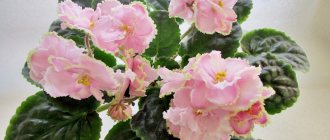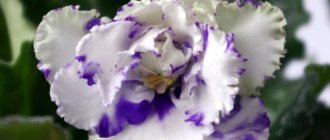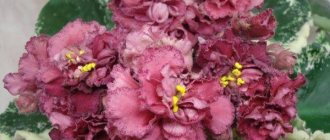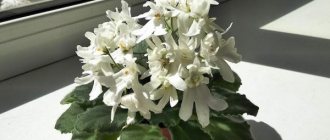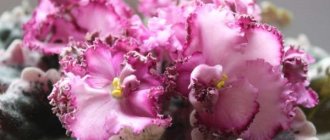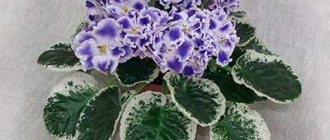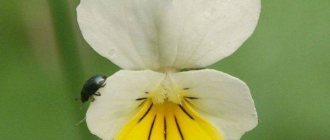The breeder of the variety is Elena Korshunova. He has been developing new varieties of Saintpaulia for more than 20 years. The author has many unique, unusual, bright varieties. Among them is the Siberian Princess.
The names of varieties bred by Elena
are written with the prefix EK . Currently, more than a hundred EK varieties are registered in the American Society of Saintpaulia Lovers.
Violet Siberian Princess was named after Alena Koshkarova.
The variety received its name in honor of Alena Koshkarova , a lover of violets and the “Siberian princess”.
violet "EK-Bullfight"
Characteristics table
| Bred by: | Korshunova E |
| Socket size: | standard |
| Description of the socket: | bright green, exhibition |
| Flower size: | especially large-flowered (8 cm) |
| Flower type: | semi-double and terry |
| Flower Shape: | star |
| Flower color: | Blood red flowers with notches |
Contents in room culture
Saintpaulia is not picky about the conditions of its maintenance - in order to maintain a healthy appearance and excellent decorative coloring of flowers, it is enough for her to follow the classical regimes, taking into account the nuances of the temperature scale :
- on windowsills in a western or eastern direction is considered ideal when installing a violet on a northern window sill, mandatory illumination with natural spectrum lamps will be required, on the southern one - some shading in the heat;
- Watering should be done in small doses, after lightly drying the upper tier of the substrate;
- Feeding can be performed according to visually confirmed need;
Violet requires proper care. - Lighting is created in a natural, long-lasting, diffuse spectrum;
- The temperature can vary between +20 + 24°C without sharp fluctuations;
- Humidity is allowed to be increased by any method except direct spraying of violets;
- The soil taken is nutritious, well aerated, permeable, with mandatory drainage;
- transplantation using the gentle transshipment method, except in unforeseen cases.
Description
There are many different varieties bred in the world, all of them are beautiful in their own way, but the “Bullfight” variety always attracts the attention of violet lovers.
History of the variety
This species of violet was bred in Togliatti by breeder Elena Korshunova; as a result, in catalogs or bulleted lists the abbreviation EK is added to the name, hence the correct name of the variety EK – Bullfight.
Leaves
The leaf blades of the variety grow in a full and dense rosette of large size. With proper care, it can reach a diameter of 30 cm.
The leaf blades are light emerald in color and have long petioles and a slightly wavy, not clearly defined wavy edge.
Flowers
The flowers are red in color and quite large. When fully bloomed, the bud is literally filled with large petals, slightly wavy along the edge.
Depending on the brightness of the lighting, Saintpaulia may slightly change the shade of its colors:
- From bright scarlet color;
- Until ruby.
The flowers, regardless of the number on the bush, do not become smaller , but grow with the same large diameter up to 8 cm.
Features and differences
The flowers are the largest among flowers that bloom in a deep red color; their diameter is 8 cm. The main distinguishing feature of this violet is that it blooms constantly. At first, 3 buds bloom on two peduncles, and then more peduncles grow and large flowers are constantly formed on the rosette, creating a magnificent head of flowers.
Reviews
Anton Ilyich. “I spent a long time understanding the intensity of the colors of the EK-Frost violet until I realized that in cool conditions Saintpaulia forms a light tonality, and in hot conditions the corollas with dark petals open. The variety turned out to be dependent on temperature.”
Frosty violet attracts the attention of many gardeners.
Growing conditions
In order for a flower to develop well, it is necessary to take into account its wishes regarding its cultivation, that is, fulfill some requirements for caring for it:
- The container for violets is not high, but wide, with a volume of no more than a liter.
- Replanting is done annually in the spring with inspection of the plant’s root system and replacement of the soil.
- Where the violet lives there should be no cold drafts.
- The temperature regime for normal violet growth should be within 18-25 degrees Celsius.
Caring for a plant at home
The Violet Siberian Princess requires proper care.
Conditions of detention
Proper watering and fertilizing
Water is the basis of plant life . Watering greatly affects the health and growth of violets. The need for watering depends on the conditions in which the violet lives:
- Light intensity;
- Air temperature and humidity;
- Plant age.
Saintpaulias are very demanding on the quality of watering. Ideally, watering should be uniform and in small portions, taking into account the characteristics of the plants.
In general, an individual approach is very important. The violet needs to be watered when the top layer of the substrate has dried , and this happens in different plants at different intervals.
When watering, you need to make sure that moisture does not get on the surface of the leaves, and especially on the growing point.
Important! The correctness of watering can be judged by the condition of the violet: if the leaves are always elastic and bright, then watering is optimal.
The basis for irrigation should be high-quality soft, settled water with a temperature of 23-25 degrees.
Professionals water violets with special devices , which are a container with a long spout or a thin hose. Air is pumped into such a device, it pushes water out of the container in a thin stream, which is directed to the edge of the earthen clod, avoiding splashing. At home, such a device can be successfully replaced by a 50-100 ml syringe with a long spout.
can also , but carefully and not often, since with such watering there is a high risk of root rotting.
With all the wealth of choice, liquid fertilizers are optimal for violets. They are easier to dose.
For good growth, violets must be fed.
Basic rules for feeding violets:
- Young rosettes need nitrogen, there should be more of it than phosphorus and potassium;
- To lay a large number of buds, phosphorus is needed;
- Potassium will increase flowering time;
- Feed from above;
- Choose a complex fertilizer containing all the main macro and microelements in chelated form;
- Sometimes simple transshipment will be more beneficial for the plant than fertilizing.
Lighting and temperature
A special feature of the EK Sibirskaya Tsarevna variety is its attitude to light . These violets bloom well and for a long time exclusively in natural diffused light.
It is best to place pots with the Princess on the windowsills of the eastern and western windows.
The variety is undemanding to temperature conditions . The optimal temperature is 20-220. For babies and cuttings, the temperature is 2-40 degrees higher and higher humidity.
It must be remembered that lowering the temperature to +130 and increasing it to +290 will cause irreparable harm to the violet.
Effect of air humidity
Saintpaulias naturally live along river banks and near waterfalls ; air humidity is very important for them. A humidity level of 60-70% will best affect the well-being of Saintpaulia. With regular watering and a comfortable temperature, adult plants feel good even at lower humidity (30-40%).
The Siberian Violet Princess loves moist air.
In winter, the air in apartments is dry and to maintain comfortable conditions it is necessary to humidify the air . Whether it’s an air humidifier or homemade products from improvised means, the choice is yours.
Soil requirements
- Ease;
- Air permeability;
- Moisture capacity;
- Sufficient amount of macro and microelements;
- Acidity 5.5-6.5;
- Absence of pathogens and pests;
- The presence of living beneficial microflora.
Important! Without properly selected, balanced soil, this Saintpaulia variety cannot be grown.
High-moor peat with adjusted acidity using additives optimal for growing Saintpaulias
Approximate soil composition :
- Greenword soil or high-moor peat – 5 parts;
- Vermiculite or Perlite – 2 parts;
- Sphagnum moss or coconut fiber - 3 parts;
- Nutrient soil – 1 part;
- You can add crushed charcoal and dolomite flour.
The finished mixture should be :
- Light;
- Fluffy;
- Well permeable to water and air;
- Not prone to tracking.
Pruning and hygiene
When growing violets, at a certain point the problem of bush formation arises . For good development of flower stalks from axillary buds, the Saintpaulia rosette should consist of approximately three tiers. The leaves below can be safely removed. Empty flower stalks, yellow, painful, damaged leaves are also removed.
Do not forget to cut off the dry and rotten parts of the violet.
As the lower leaves are removed, the stem of the violet is exposed . The leafless stem is covered with fresh soil.
All violets in your collection require weekly inspection. During this inspection, the following is monitored :
- Soil moisture;
- The need to add substrate;
- Presence of signs of parasites (cobwebs, wilting) and diseases (wet areas, spots);
- The need to remove leaves and flower stalks.
Dust is very harmful to the fluffy leaves of violets. I wash it off under the tap, after placing the pot in a bag and tying it so that the water does not get on the soil. Each leaf is washed separately under a thin stream of warm water.
Reproduction methods
The Siberian Princess variety reproduces well :
- Leaf cuttings;
- And kids.
Transplant rules, rejuvenation
The Siberian Princess needs to be replanted in several cases :
- Violet grows in this substrate for more than 2 years;
- The roots have grown through the drainage hole;
- The violet fades when the substrate is normally moistened;
- Soil acidification has occurred;
- There was a need to rejuvenate or deepen the plant.
Transfer procedure:
- Carefully remove the violet from the pot;
- Shake off/remove as carefully as possible most of the old soil;
- Remove too long, old, damaged roots;
- Place the violet in the new substrate;
- After a day, the plant needs to be watered and soil added (if necessary).
Important! The pot size remains the same!
The violet needs to be replanted once a year.
Princess rejuvenation is carried out when the plant is 2.5-36 years old. If you leave the plant for a longer period, the flowering will not be as abundant, and the flowers will become small. The plant is rejuvenated by cutting off the “head” (the growing point and 2 tiers of leaves) and then rooting it in the greenhouse.
Planting and propagation
Violets are propagated in three ways:
- Using a daughter socket;
- Using a sheet;
- Using seeds.
The last method is used only by breeders and is practically not available to ordinary flower lovers.
To obtain daughter rosettes, the old violet is cut off and rooted, but the stump that remains after the cut is not removed. Daughter rosettes appear on it, which are later re-rooted into separate small pots.
Leaf propagation occurs in the standard way:
- Cut off the leaf.
- Immerse 2 cm into the soil and lightly squeeze the soil around the cutting.
- Cover with a glass jar and water lightly if the soil is dry.
Useful video
Find out in the video what mistakes should not be made when caring for violets: Watch the video on how to plant a violet leaf: Interesting facts in the video on how to properly transplant and rejuvenate a violet: Find out in the video what diseases violets have:
Violet Pink Watercolor
A magnificent variegated variety was presented to flower growers as a result of the focused work of Moscow breeder Konstantin Lvovich Morev. Violet began to appear at exhibitions in 2006.
Description of the variety
The violet forms a leveled rosette of the standard type , although due to its large diameter the variety passes along the upper limit of the characteristic. As the rosette grows, the leaves may curl down, trying to hug the pot - this violates the varietal description and decorativeness.
In comfortable conditions, the sheet plates are folded in tiers according to a mosaic principle , creating an original silhouette of an exhibition rosette.
The leaves of Saintpaulia are distinguished by a weakly expressed variegated color: the main background of a shade of dark green is framed by a thin whitish-cream braid and the same tone is sprayed on the outer part of the plate. The leaves have a rounded-pointed configuration, finely serrated edges and a smooth, shiny surface structure.
Violet blooms for a long time, large corollas of semi-double or double type are formed. Each petal has strongly wavy edges, making the flower appear larger.
The coloring consists of two colors - a white base color, on which the prints of an artistic brush of a pink hue are applied. As a result, a chic white edging appears on the petals .
Sports
The violet is capable of rare sporting with the formation of monochromatic pink corollas, almost losing their lush frills.
Features of maintenance and care
The variety is ideal for indoor cultivation , suitable for beginners as one of the first plants in the collection:
- very resistant to unfavorable conditions, withstands minor violations of maintenance regimes;
- features simple care methods;
- actively reproduces and produces numerous children;
- blooms with large buds, especially in conditions of sufficient lighting.
CAREFULLY! Violet reacts negatively to untimely, frequent or large quantities of separation of leaf blades for propagation - it can postpone the flowering time or abandon it altogether.
You should carefully monitor the amount of watering, since violets are highly susceptible to rotting if there is excessive accumulation of moisture in the flowerpot.
Reviews
Serge. “K. Morev’s every variety is perfect. “Pink Watercolor” is no exception: exhibition rosette, gorgeous flowers, strong peduncles. You grow a bush and rejoice.”


